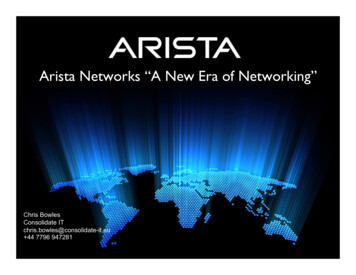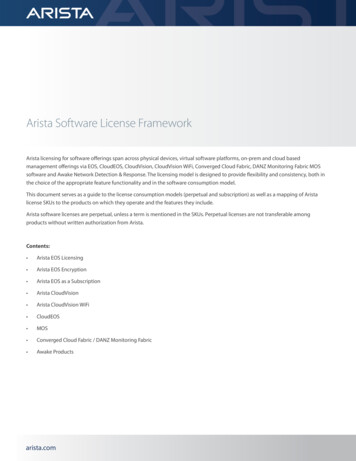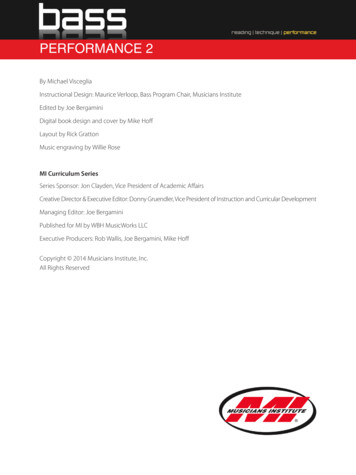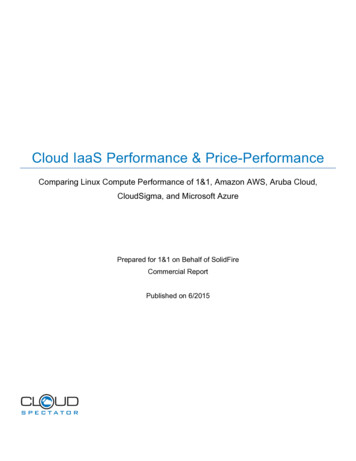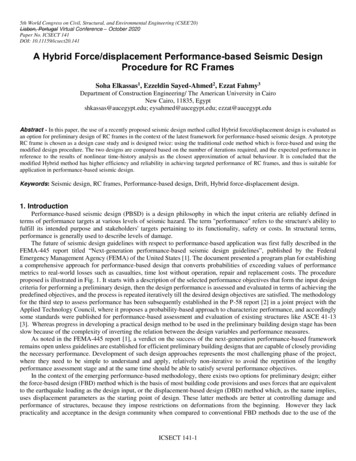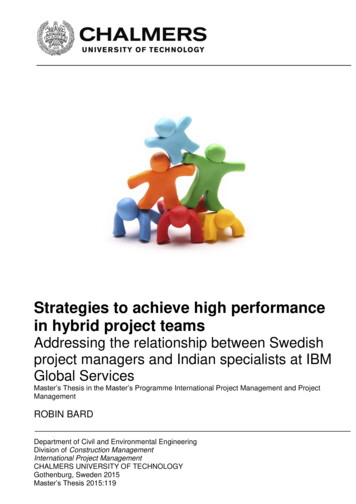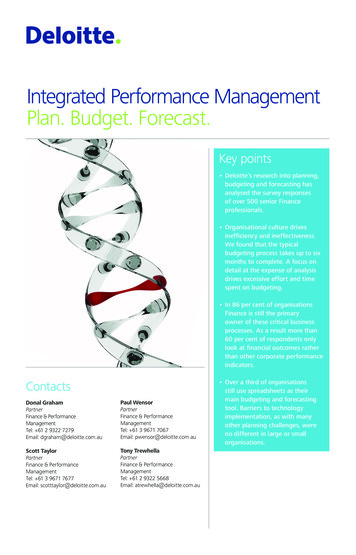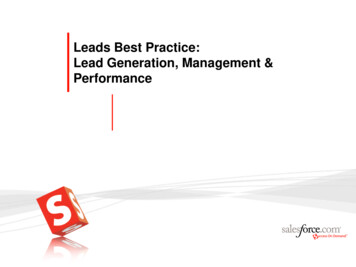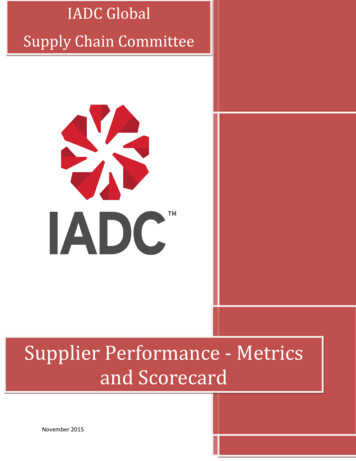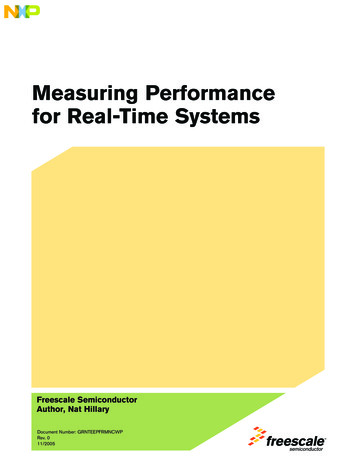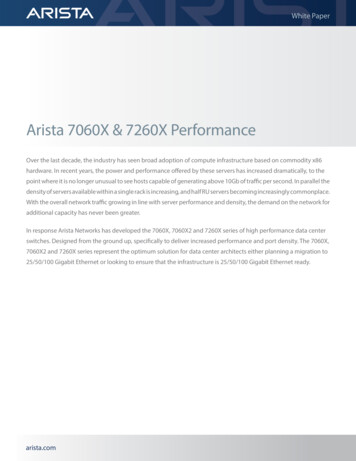
Transcription
White PaperArista 7060X & 7260X PerformanceOver the last decade, the industry has seen broad adoption of compute infrastructure based on commodity x86hardware. In recent years, the power and performance offered by these servers has increased dramatically, to thepoint where it is no longer unusual to see hosts capable of generating above 10Gb of traffic per second. In parallel thedensity of servers available within a single rack is increasing, and half RU servers becoming increasingly commonplace.With the overall network traffic growing in line with server performance and density, the demand on the network foradditional capacity has never been greater.In response Arista Networks has developed the 7060X, 7060X2 and 7260X series of high performance data centerswitches. Designed from the ground up, specifically to deliver increased performance and port density. The 7060X,7060X2 and 7260X series represent the optimum solution for data center architects either planning a migration to25/50/100 Gigabit Ethernet or looking to ensure that the infrastructure is 25/50/100 Gigabit Ethernet ready.arista.com
White PaperSwitch OverviewThe Arista 7060X, 7060X2 and 7260X Series are purpose built, flexible Data Center switches in compact and energy efficient formfactors with wirespeed layer 2 and layer 3 forwarding, combined with advanced features for software defined cloud networking. Afamily of fixed configuration 1RU and 2RU systems, the 7060X, 7060X2 and 7260X series support a variety of interface form factorand speed options.Designed precisely to meet the challenges of dense 25, 50 and 100 Gigabit Ethernet switching, the 7060X, 7060X2 and 7260Xseries feature a flexible combination of 10GbE (SFP ), 40GbE (QSFP , QSFP100) and 25GbE/50GbE/100GbE (QSFP100) interfaces,supporting up to 64 ports of 100GbE in a single system. The table below highlights the interface and speed combinations.Table 1: Arista 7060X & 7260X Series overviewSwitch Model7060CX-32S7260QX-647260CX-647260CX2-32Switch Height1RU2RU2RU1RUPorts32 x QSFP1002 x SFP 64 x QSFP 2 x SFP 64 x QSFP1002 x SFP 32 x QSFP1002 x SFP Max. 10GbE Density1302258130Max. 25GbE Density128-256128CharacteristicMax. 40GbE Density32646432Max. 50GbE Density64-12864Max. 100GbE Density32-6432Max. I/O Rate (Tbps)6.4Tbps5.12Tbps12.8Tbps6.4TbpsMax. Forwarding 500-1500ns450nsPacket Buffer Memory16MB64MB22MBAirflow DirectionFront-to-Back or Back-to-FrontThe Emergence of 25GbEAs CPU, memory and bus technologies continue to evolve, the capacity for both virtualized and physical servers to generate morethan 10Gbps of traffic is becoming increasingly commonplace. This level of performance is no longer limited to high-end customservers, but similarly applies to many of the commodity-based products available on the market today.Until now, this requirement has presented a significant challenge to Network Architects attempting to not only exceed thecurrent server requirements, but also without multiplying the cost of network infrastructure. This was particularly difficult as themultiplicative cost of the network is a direct function of how higher speed technologies have traditionally been delivered.10GbE technology is a single lane solution, in which data is run over either a single pair of fiber or a copper cable. Due totechnological limitations, clocking that single lane at rates higher than 10Gbps has previously not been possible, therefore existingtechnologies have delivered higher speeds through parallel cables or optics. Fundamentally a 40GbE interface is comprised of4x10GbE lanes, whether the transmission medium is a parallel cable, multiple wavelengths or multiplexed 10G signals. Whilst 40GbEtechnology has seen a cost reduction over recent years, the overall cost continues to be roughly 4X the price of a 10G technology,due to the nature of its parallel design. In order to meet the next generation technical and commercial challenges head on theindustry needed a technology that was based on a higher clock rate, facilitating higher data rates over a single lane.Recognizing these clear technology drivers Arista Networks was a founding member of the 25 Gigabit Consortium. The 25GConsortium is an open organization for members to enable the transmission of Ethernet frames at 25 or 50 Gigabit per second andto promote the standardization and improvement of the interfaces for applicable products.arista.com
White PaperThe 25GbE technology provides an alternative to based parallel options with a more cost effectiveserial approach, enabling the delivery of significantly more packets per second, over a single lane.This development ensures 25GbE delivers 2.5X the performance at the same cost as 10GbE.25GbE also provides a convenient, cost effective upgrade path to higher speeds such as 50GbEand 100GbE. Leveraging the same parallel approach that enabled 40GbE technologies, 50GbE and100GbE are also parallel distributions of two and four 25GbE lanes respectively. By grounding this parallelism upon a higher clockrate of 25Gb per lane, 50 GbE and 100GbE provide architects with higher performance, higher density and reduced cost points. Thisapproach enables a system based on 25Gb technology to deliver 2.5X the I/O capacity or 2X the interface density in the same formfactor and at similar price points.Data center operators looking to maximize server throughput, minimize per node connectivity costs while retaining maximumnetwork scalability are evolving all network requirements to 25GbE based on these fundamental concepts.In response to this demand, the Arista 7060CX-32S, 7060CX2-32S and 7260CX-64 high performance systems have been designedto facilitate 25GbE, 50GbE or 100GbE connectivity in compact form factors, providing 32 or 64 100GbE interfaces in 1RU and 2RUrespectively. Each physical port can be individually configured as a single 100GbE, dual 50GbE or quad 25GbE interfaces. Basedaround the latest QSFP100 optic they deliver high density without compromises on system performance, scale or functionality.Investment ProtectionMany large organizations perform infrastructure migration as a phased process. There are a variety of motivating factors behindthis, including operational restrictions, ongoing CapEx budgets or in many cases the sheer scale of work required. Regardless ofjustification, the industry has a clear requirement for investment protection and interoperation between generations of architecture.The QSFP100 interfaces in the 7060CX-32S, 7060CX2-32S and 7260CX-64 platforms are ideally suited to meeting this requirement.While Arista QSFP100 based interfaces naturally support a versatile choice of 25, 50 and 100GbE options, the exact same interfacesalso support current 10/40GbE technologies, requiring only a change in the pluggable optic. This empowers architects to designand deploy an Arista 7060X, 7060X2 or 7260X infrastructure based on 10/40GbE technologies today, then evolve over time to25/50/100GbE connectivity. Migrating entire racks, or individual hosts as the application or business demands it, without requiring areplacement of physical switching infrastructure.Despite clear benefits, this modular approach to migration has traditionally being limited by the business impact of migrating liveservices. Legacy architectures typically require a full system reload when changing the speed of an interface. This forces operationsteams towards the batch migration of services in order to limit the number of system outages and required number of maintenancewindows.The Arista 7060X, 7060X2 and 7260X entirely negate this limitation by optimizing the programming of the underlying packetprocessor. This provides a great number of architectural and performance advantages, including the ability to allow the migrationof an interface between any combination of speeds without the requirement for either a system or process reload, ensuring that thespeed migration of one application has no functional or operational impact on any other services.The 7060X Series at a GlanceAs networks continue to diversify, a single location often comprises a multitude of technologies and interface speeds. The 7060Xand 7260X series address that challenge by providing flexibility in both scale and connectivity. With interfaces supporting 10G, 25G,40G, 50G and 100G Ethernet speeds, the 7060CX and 7260CX series present a wide range of options for interconnecting a variety ofcurrent or next generation infrastructures into a common leaf/spine network.arista.com
White PaperFigure 1: Arista 7060X & 7260X series overviewAt their core the 7060X, 7060X2 and 7260X series arespecifically developed to address the requirements forincreasing server and storage interface speeds. Faster hostconnectivity gives rise to a network requirement for theforwarding of a significantly greater number of packetsper second. In order to meet this requirement the 7060X,7060X2 and 7260X feature an optimized forwardingpipeline supporting wire-rate forwarding even underextreme loads.Figure 2: Arista 7060X & 7260X throughputNumerous additional pipeline enhancements provide a variety of benefits, including low latency from 450ns and consistently lowjitter under varying loads.Figure 3: Arista 7060X & 7260X forwarding latency and jitterarista.com
White PaperThe 7060CX-32S and 7260QX-64 offer 16MB of packet buffer, allowing the system tolerance for microbursts, avoiding one of theprimary triggers of application performance degradation, dropped packets. While the 7260CX-64 has a total of 64MB of packetbuffer, shared across 4 port groups.The 7060CX-32S is a 1 RU system with 32 QSFP100 ports and 2 SFP ports.Each QSFP100 port can be individually broken out into 4 ports of 10GbE or25GbE; 2 ports of 50GbE or used as a single port of 40GbE or 100GbE.Figure 4: Arista 7060CX-32S seriesFigure 5: Arista 7260QX-64 seriesThe 7260QX-64 is a 2 RU system that offers 64 QSFP ports and 2 SFP ports. The QSFP interfaces each support wirespeed 40GbE, enablinghigh density with a single chip design that ensures latency remains below550ns regardless of ingress and egress port mappings, while maintainingconsistently low jitter.The 7260CX-64 is a 2 RU system that provides 64 QSFP100 ports and 2SFP ports. Each QSFP100 port can be individually broken out into 4 portsof 10GbE or 25GbE; 2 ports of 50GbE or used as a single port of 40GbE or100GbE.Figure 6: Arista 7260CX-64 seriesThe 7060CX2-32S is a 1RU system that re-implements the 7060CX-32 butprovides packet memory buffer that is increased by 40% to 22MB to addresslossless network environments. Featuring 32 QSFP100 and two SFP ports,all of which can be enabled concurrently. Each QSFP100 interface can beindividually broken out into 4 ports of 10GbE or 25GbE; 2 ports of 50GbE orFigure 7: Arista 7060CX2-32S seriesused as a single port of 40GbE or 100GbE. The 7060CX2-32S also featuresfull IEEE support for 802.3by (25GbE) including RS-FEC on all ports. This allows interfaces run at 25GbE to support maximum reachover multimode fiber, ensuring that 25GbE is no longer limited to an intra rack technology.All four products share common system architecture, built on the same underlying system on chip silicon, to ensure consistentperformance and feature parity. With typical power consumption of under 7W per 100GbE port on the 7060CX-32S, the 7060X,7060X2 and 7260X series provide industry leading power efficiency coupled with power supplies that are rated at greater than 94%efficiency at typical loads, which is equivalent to platinum level. All 7060X, 7060X2 and 7260X models feature reversible airflowoptions providing the flexibility to ensure suitability at the top of rack, middle of row, end of row, or at the network spine layer.The 7060X, 7060X2 and 7260X series run a single EOS binary image which is common across the entire Arista product portfolio,simplifying certification and compliance, while removing legacy challenges such as release train divergence, or platform specificinconsistency and recurring software defects. Building upon the solid foundations of EOS enables the 7060X, 7060X2 and 7260XSeries to deliver advanced features for big data, cloud, SDN, virtualized and traditional enterprise network designs.Efficient Non-Stop OperationsThe latest developments of cloud computing have given rise to a new whole new generation of challenges, many of which revolvearound the unparalleled demand for storage and compute capacity. While such requirements are often at the forefront of anydesign conversation, many more traditional concerns remain equally relevant for Network Architects.arista.com
White Paper Power budgets continue to restrict the deployment of compute resources far more than physical footprint. The 7060X, 7060X2and 7260X continue Arista’s commitment to produce lower power draw, environmentally efficient products, which are powerefficient and generate less heat avoiding costly and complex upgrades to facilities, and allowing for higher server density ineach rack. Parity errors dominate the list of common difficulties by Operations teams globally. This is due to the entirely random nature ofthese errors, combined with the significant impact of a device reload (best case at a planned time, worst case in the middle ofa business day). The 7060X, 7060X2 and 7260X series, as with all Arista products, includes significant custom health monitoringmechanisms for parity error detection and handling. These ensure that errors can be detected and corrected on the fly, with nodiscernable impact to the device avoiding system reloads. Yellow Zone Upgrades add increasing complexity for Network Operations teams executing maintenance tasks. Increaseduptime expectations make it difficult for Network Operations teams to secure maintenance windows, with many organisationsoffering production time ‘yellow zone’ upgrades. As a result of this, the demand has transitioned away from functionallycomplex, device centric, ‘zero lo
White Paper Arista 7060X & 7260X Performance Over the last decade, the industry has seen broad adoption of compute infrastructure based on commodity x86 hardware. In recent years, the power and performance offered by these servers has increased dramatically, to the point where it is no longer unusual to see hosts capable of generating above 10Gb of traffic per second. In parallel the density .
